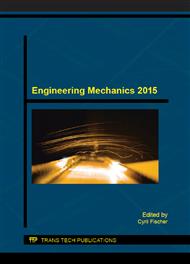[1]
J. Smay, G. Gratson, R. Shepherd, J. Cesarano, J. Lewis, Directed colloidal assembly of 3D periodic structures, Adv. Mater. 14 (2002) 1279-1283.
DOI: 10.1002/1521-4095(20020916)14:18<1279::aid-adma1279>3.0.co;2-a
Google Scholar
[2]
J.E. Smay, J.A. Lewis, Solid Free-Form Fabrication of 3-D Ceramic Structures, in: N.P. Bansal, A.R. Boccaccini (Eds. ), Ceramics and Composites Processing Methods, John Wiley and Sons, Hoboken, 2012, pp.459-484.
DOI: 10.1002/9781118176665.ch13
Google Scholar
[3]
K. Cai, B. Román-Manso, J.E. Smay, J. Zhou, M.I. Osendi, M. Belmonte, P. Miranzo, Geometrically Complex Silicon Carbide Structures Fabricated by Robocasting, J. Am. Ceram. Soc. 95 (2012) 2660-2666.
DOI: 10.1111/j.1551-2916.2012.05276.x
Google Scholar
[4]
B. Román-Manso, S.M. Vega-Díaz, A. Morelos-Goméz, M. Terrones, P. Miranzo, M. Belmonte, Aligned carbon nanotube/silicon carbide hybrid materials with high electrical conductivity, superhydrophobicity and superoleophilicity, Carbon 80 (2014).
DOI: 10.1016/j.carbon.2014.08.046
Google Scholar
[5]
P. Miranda, E. Saiz, K. Gryn, A.P. Tomsia, Sintering and robocasting of β−tricalcium phosphate scaffolds for orthopaedic applications, Acta Biomater. 2 (2006) 457-466.
DOI: 10.1016/j.actbio.2006.02.004
Google Scholar
[6]
A. Kruisová, H. Seiner, P. Sedlák, M. Landa, B. Román-Manso, P. Miranzo, M. Belmonte, Metamaterial behavior of three-dimensional periodic architectures assembled by robocasting, Appl. Phys. Letters 105 (2014) 211904.
DOI: 10.1063/1.4902810
Google Scholar
[7]
R.V. Craster, S. Guenneau, editors, Acoustic Metamaterials: Negative Refraction, Imaging, Lensing and Cloaking, Springer Series in Materials Science Vol. 166, Springer, London, (2013).
DOI: 10.1007/978-94-007-4813-2
Google Scholar
[8]
A. Briggs, Acoustic Microscopy, Claredon Press, Oxford, (1992).
Google Scholar
[9]
COMSOL multiphysics user's guide. Version 3. 5a; (2008).
Google Scholar
[10]
Xia, Z., Zhang, Y., Ellyin, F. A unified periodical boundary conditions for representative volume elements of composites and applications, Int. J. Solids Struct., 40 (2003), 1907-(1921).
DOI: 10.1016/s0020-7683(03)00024-6
Google Scholar
[11]
R.G. Leisure, F.A. Willis, Resonant Ultrasound Spectroscopy, J. Phys.: Condens. Matter 9 (1997) 6001-6029.
DOI: 10.1088/0953-8984/9/28/002
Google Scholar
[12]
P. Sedlák, H. Seiner, J. Zídek, M. Janovská, M. Landa. Determination of All 21 Independent Elastic Coefficients of Generally Anisotropic Solids by Resonant Ultrasound Spectroscopy: Benchmark Examples, Exp. Mech. 54 (2014) 1073-1085.
DOI: 10.1007/s11340-014-9862-6
Google Scholar
[13]
T.L. Anderson, Fracture Mechanics: Fundamentals and Applications, 3rd edition, Taylor & Francis CRC Press, Boca Raton, (2004).
Google Scholar
[14]
P. Miranda, A. Pajares, E. Saiz, A.P. Tomsia, F. Guiberteau, Fracture modes under uniaxial compression in hydroxyapatite scaffolds fabricated by robocasting, J. Biomed. Mater. Res. A 83 (2007) 646-655.
DOI: 10.1002/jbm.a.31272
Google Scholar
[15]
M. Genet, M. Houmard, S. Eslava, E. Saiz, A. P. Tomsia, A two-scale Weibull approach to the failure of porous ceramic structures made by robocasting: Possibilities and limits, J. Eur. Ceram. Soc. 33 (2013) 679-688.
DOI: 10.1016/j.jeurceramsoc.2013.01.014
Google Scholar
[16]
T. Koudelka, T. Krejčí, J. Kruis, Moderate Use of Object Oriented Programming for Scientific Computing, in B.H. V. Topping, J.M. Adam, F.J. Pallarés, R. Bru, M.L. Romero (Eds. ), Proceedings of the Seventh International Conference on Engineering Computational Technology, CivilComp Press, Stirlingshire, 2010, 68.
DOI: 10.4203/ccp.94.68
Google Scholar
[17]
E. Rohan, B. Miara, F. Seifrt, Numerical simulation of acoustic band gaps in homogenized elastic composites, Int. J. Eng. Sci. 47 (2009) 573-594.
DOI: 10.1016/j.ijengsci.2008.12.003
Google Scholar
[18]
V. P. Smyshlyaev, Propagation and localization of elastic waves in highly anisotropic periodic composites via two-scale homogenization, Mech. Mater. 41 (2009) 434-447.
DOI: 10.1016/j.mechmat.2009.01.009
Google Scholar
[19]
J.P. Wolfe, Imaging Phonons (Acoustic Wave Propagation in Solids), Cambridge University Press, Cambridge, (1998).
Google Scholar


